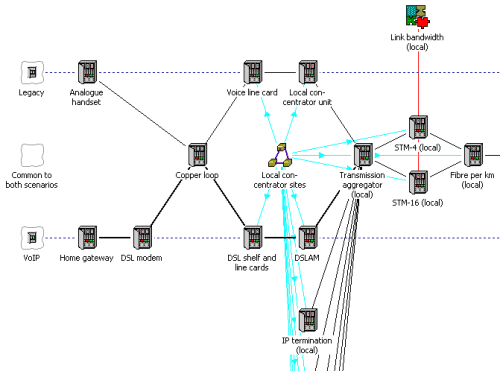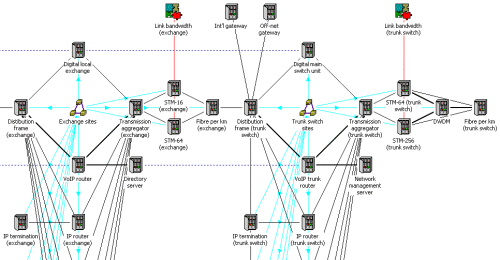The new IP version 6 supports the implementation of guaranteed bandwidth and QoS
levels, while the existing solutions for multi-protocol label switching (MPLS) offer
the potential to make VoIP truly scaleable. In conjunction with the highly-optimised
compression algorithms implemented in the latest audio codecs, there exists the
real potential for an eight-fold reduction in the transmission requirements for
voice traffic with no perceptible loss of quality.
However, incumbent operators and other tier-1 carriers, already preoccupied with
cash conservation and nervous about revenue/margin erosion in the tightly regulated
and highly competitive voice market, are justifiably cautious about full-scale migration
of what remains their central product without the example and inspiration of a successful
first mover. This, in spite of the incremental revenue potential from value-added,
integrated data and voice services, and the risk that a competitor could increase
market share by taking the lead on technology, products and pricing.
We have started work on a new reference model examining the economic case for
the shift to VoIP in the public switched telephony network, focusing on the historically-diverse
infrastructure of the incumbent operator as a gauge of the true complexity of this
toughest-of-all techno-economic questions.
The hype should excite the consumer too
One of the major gaps in the message promoting VoIP is the benefit for the consumer.
The techno-centric view focuses on the statistical advantages of the packet-based
transport, and the profound wider cost savings of a single, rational IP platform
rather than IP and PSTN in parallel. This is pretty compelling for the network manager,
but unfortunately rather ‘so what?’ for the end-user, who is generally happy with
the mature fixed telephony service, unless the reduced transport costs result in
reduced tariffs.
The thing about fixed voice is that it has been around for a long time now. While
still enjoying a gradual evolution of additional services, such as caller-line identification
and voicemail, the basic service hasn’t changed much in the twenty years since digital
exchanges were first introduced. Compare this to the rapid development of mobile
telephony in this interval. Not only does mobile offer the immediate appeal and
convenience of communication on the move, the extended feature-set of mobile handsets
and networks has undoubtedly also contributed to the spectacular growth of mobile
services.
In today’s tight financial conditions, any large-scale initiative must achieve real
cost reductions and increase – or at least safeguard – existing revenues. So any
strategy for adopting packet-based voice transmission should consider equipment
and services provided to the mass-market consumer as an essential factor. Therefore
our model will extend from the core trunk network, through the local exchange and
local concentrator, right out to the ‘home gateway’ which may inspire the end-user
to embrace next-generation voice services. Given the right vision, which may deliver
secure business voice communication and click-to-dial features on the home PC, any
concerns as whether VoIP will actually work will be swept aside by the irresistible
advance of technology.

The economic case must engage with the network
The incumbent operator has an extensive historical investment in the local loop,
with line cards at the local concentrator providing the primary interface between
analogue voice and 64kbit/s circuits, linked to a national network of digital local
exchanges and trunk voice switches. The PSTN network is substantially depreciated
but its operational life may be prolonged for at least another decade. However,
traditional circuit-based voice represents a vast overhead in transmission and switching
capacity, with associated operating expenditure that will only increase as spares
become scarce. Better to migrate to soft-configurable, low-maintenance VoIP routers,
and to make perhaps half the existing transmission capacity available for the inexorable
growth in data traffic
The challenge for a credible model of this infrastructure, and the corresponding
next-generation scenario, is to capture the specifics of a network which will typically
have evolved on an as-needed basis, with varied components from multiple vendors,
rather than according to a consistent design. We aim to use template replication
to produce a model separately categorised by type and location of loop concentrators,
local exchanges and trunk switches, together with local links, dual-homed exchange
links and trunk circuits.

The model will accurately reflect the transition from the legacy PSTN to the VoIP
network, providing a detailed breakdown of the kinds of investment that will be
required and the impact on existing capex and operating costs. In addition, it will
define new services, such as click-to-dial, which could help raise ARPUs, or at
least protect the fixed voice market as the traditional voice product declines in
value.
Rather than a simple go/no-go comparison, the model will assess a number of different
scenarios, analysing the impact of revenues from new services on the pace of transition
which can be afforded. The growth of broadband in the local loop may emerge as the
key enabler which drives the associated IP infrastructure deployment and which then
prepares the ground for VoIP to be truly cost-effective when transmission capacity
is freed up as the PSTN is phased out.